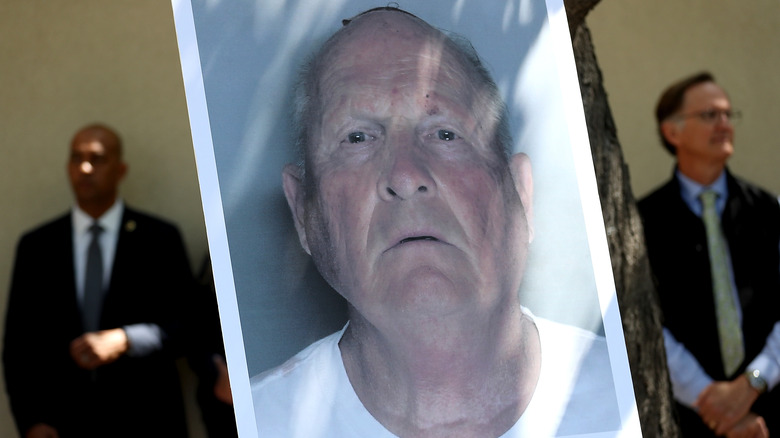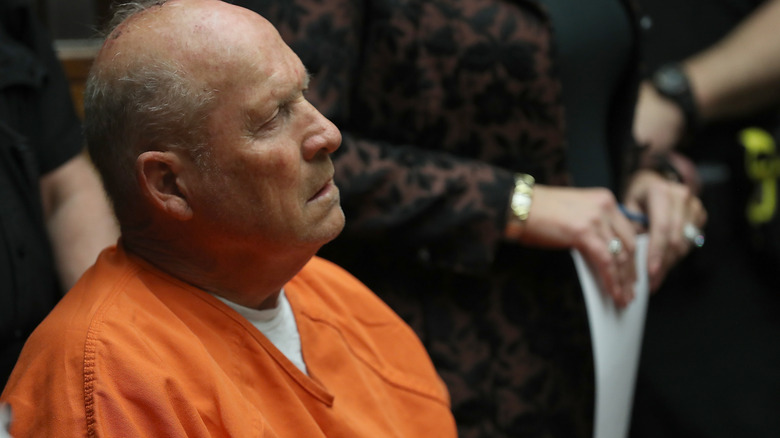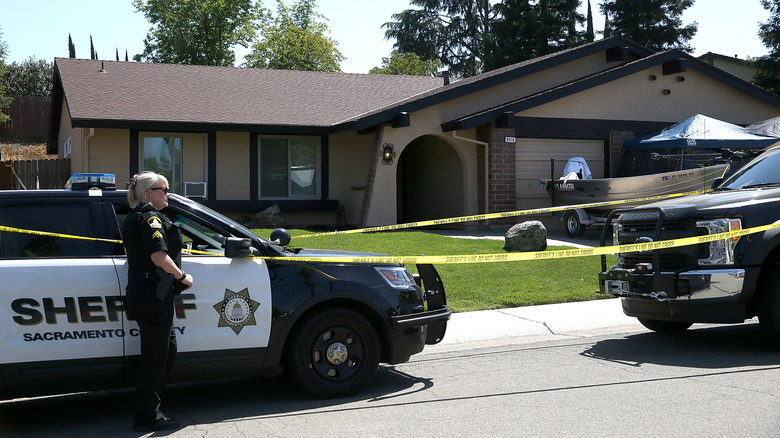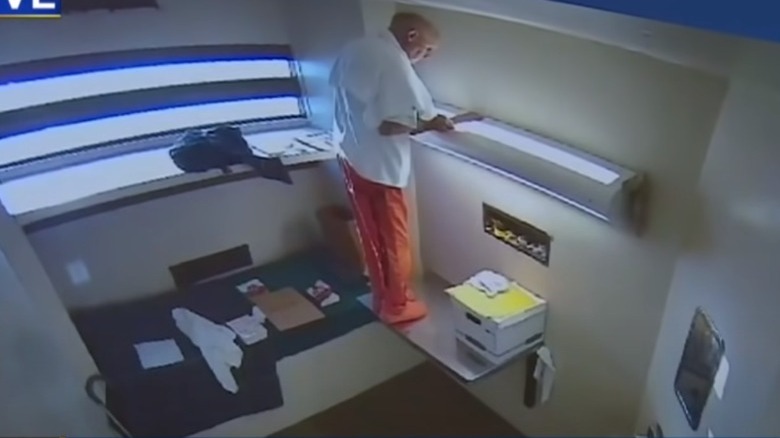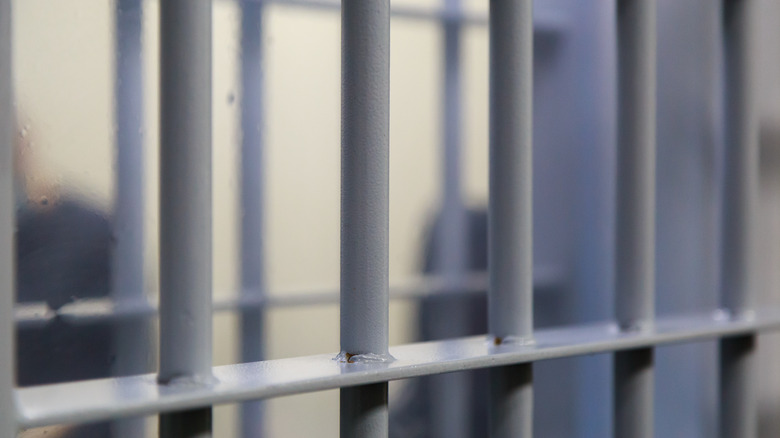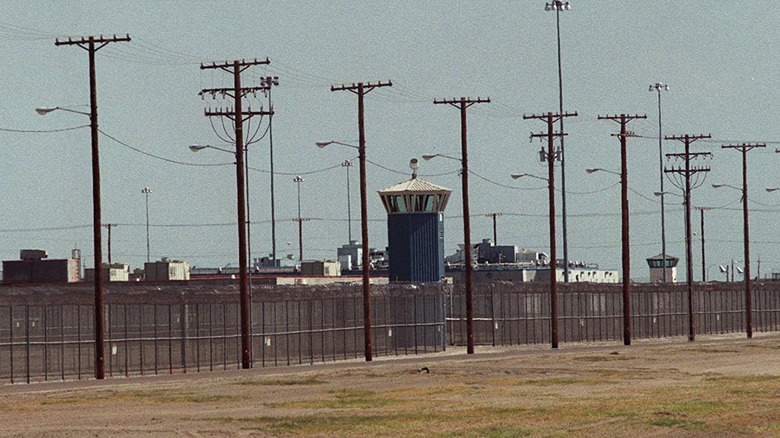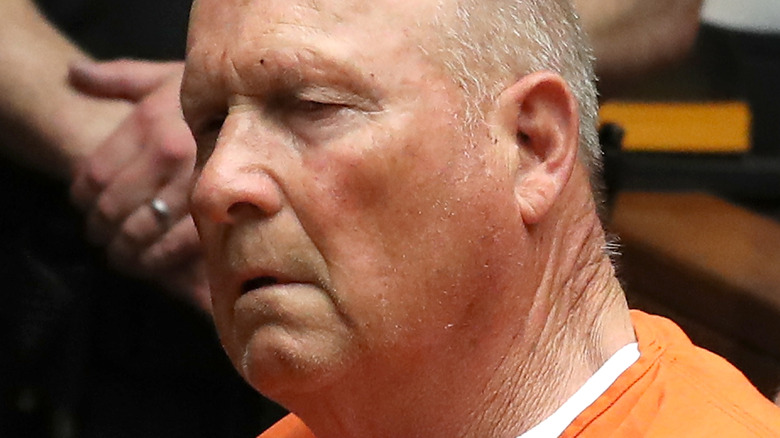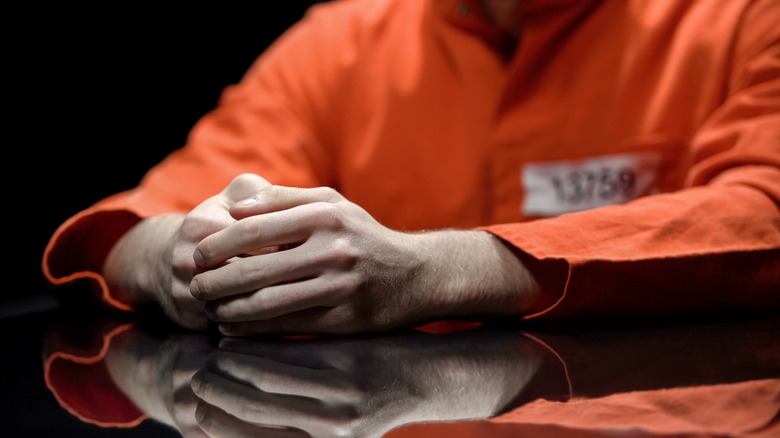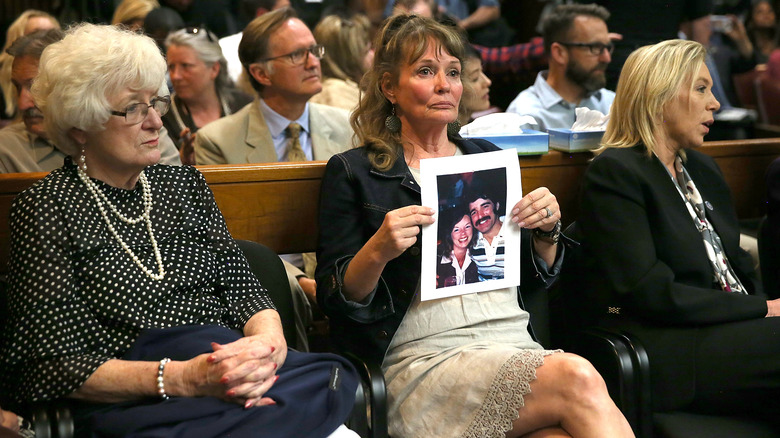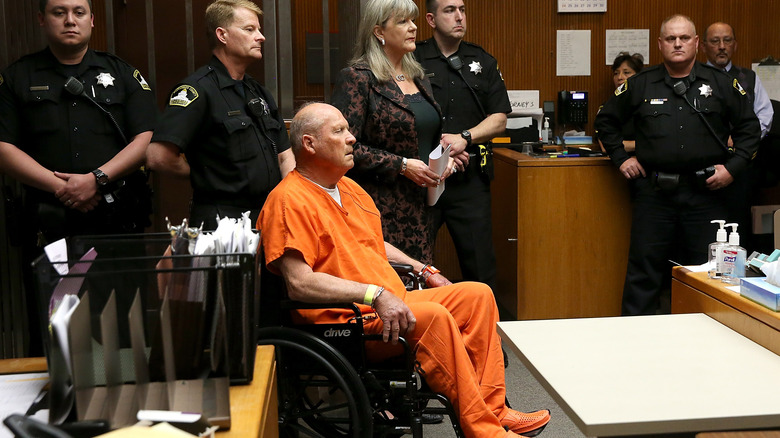What The Golden State Killer's Life In Prison Is Really Like
When Joseph James DeAngelo Jr. was arrested in 2018, it had been decades since the so-called Golden State Killer (also known as the East Area Rapist) terrorized sections of California. His crimes spanned the 1970s and 80s and left dozens of victims.
The Los Angeles Times says that the Golden State Killer was finally caught and the case was solved with genetic genealogy, using DNA and genetic testing sites that have helped countless people build family trees. CBS News says that by the time the notorious serial killer was caught, he was 74 years old. That's a long time to wait for justice, and here's the weird thing: The LA Times reported that when the attacks, assaults, and rapes were happening, the prison sentence for a guilty conviction for rape could be as little as one year behind bars. Sound awful? Just as bad was the fact that he was once described by law enforcement as a "gentlemanly" sort. At the same time, newscasters disturbingly tried to reassure a terrified state that while victims were repeatedly raped, they were also left pretty much "unharmed" (via LA Times).
So, while it took a while for DNA technology to catch up and allow for the arrest and conviction of DeAngelo, it also means he's going to be spending the rest of his life in jail instead of getting a slap on the wrist. What, exactly, does that mean for him?
If you or anyone you know has been a victim of sexual assault, help is available. Visit the Rape, Abuse & Incest National Network website or contact RAINN's National Helpline at 1-800-656-HOPE (4673).
The sentencing: Why was the death penalty off the table?
By the time Joseph James DeAngelo Jr. was done confessing to the crimes he'd been connected to with DNA, he had issued a guilty plea to 13 murders and 13 kidnappings. That wasn't it, though: If the statute of limitations hadn't expired, there would have been another 42 rapes, along with another 161 counts of crimes like robbery, burglary, and attempted murder, according to the Los Angeles Times.
Although an Orange County prosecutor involved in the case called him "the poster child for the death penalty," DeAngelo was not granted this sentencing. Instead, NBC News reported that DeAngelo had been handed consecutive life sentences without parole, and went on to say that the death penalty had been taken off the table in exchange for his confession.
Admitting to the crimes, prosecutors said, was incredibly important for survivors and family members. There's also the matter of his age: Given that it could take a whopping 30 to 35 years to go from trial to execution and DeAngelo was already 74 years old, it was likely he would die from old age on death row (like most people awaiting the death penalty in California). Instead, what life he had left would be spent behind bars, and families would get some much-needed closure.
If you or anyone you know has been a victim of sexual assault, help is available. Visit the Rape, Abuse & Incest National Network website or contact RAINN's National Helpline at 1-800-656-HOPE (4673).
He was initially in a psychiatric ward on suicide watch
Neighbors seemed shocked when Joseph James DeAngelo Jr. was arrested — uneventfully — at his home in April of 2018. According to ABC News, he was taken into custody while law enforcement searched his house, looking for some of the items stolen from victims over the years.
Shortly after his arrest, Sacramento County Sheriff Scott Jones confirmed (via CBS News) that he was being held at the county jail in a psychiatric ward. Jones also added that this first stint in prison for the former police officer was being spent under strict supervision, as he had also been put on suicide watch.
More than two years had passed when CBS News reported that DeAngelo had entered his guilty plea with the courts, shedding a little more light on what had been going on behind closed doors. DeAngelo, they said, had blamed his crimes on an inner voice that he named Jerry. "I didn't have the strength to push him out," DeAngelo said. "He made me. He went with me. It was like in my head, I mean, he's a part of me. I didn't want to do those things."
If you or anyone you know is having suicidal thoughts, please call the National Suicide Prevention Lifeline by dialing 988 or by calling 1-800-273-TALK (8255).
The Golden State Killer is constantly on video
When Joseph James DeAngelo Jr. appeared in court, the elderly, wheelchair-bound man accused of some of the most horrific crimes in California history hardly seemed capable of committing those same crimes. He seemed weak and confused, and according to retired Contra Costa County District Attorney investigator Paul Holes, he often appeared catatonic while being questioned by police. Holes also said (via Oxygen) that it was all an act. "Don't believe this guy that you see being wheeled into court. That's not who he is," Holes explained, going on to describe him as fit and active — something SFGate reported neighbors substantiated. "He's the ultimate tactician, and his defense strategy is going to try and minimize what's going to happen to him."
After his conviction, the DA's office released some of the video footage of DeAngelo in his cell (via KCRA NBC). Interestingly, it shows him doing things like exercising and climbing on furniture to reach things — far different from the image he presented in court. The Mercury News reported that a video from the prior year showed him "committing a sexual act while watching someone outside of his cell," and ultimately, it was all deemed inadmissible in court, and was not shown prior to his sentencing.
It took two months for his transfer to North Kern State Prison
When Joseph James DeAngelo Jr. was handed his sentence of life behind bars, victims and their families appealed to the courts to have him locked away in a dark, distant place. CBS News says that although they were pretty united in the idea, it didn't really matter — it was up to the state's corrections department to evaluate him and decide where he was going to go. Factors like his age, notoriety, medical and mental health requirements, and the need for safety were going to be impacting the decision, which they also noted wasn't going to happen for a while.
Why? DeAngelo was going to spend some time sitting in Sacramento County holding because of COVID-19. At the time he was sentenced, the state had put a halt to all transfers in hopes of stopping the spread of the virus through prison systems.
It wasn't until November 2020 — about two and a half months after his sentencing — that KCRA NBC reported that he had been moved to North Kern State Prison. Even that wasn't a final destination, as they described it as a "reception center" responsible for holding inmates while the final housing decisions are made.
It was then decided he'd be transferred to the Corcoran State Prison
Just a few days into February 2021, the Visalia Times Delta reported that Joseph James DeAngelo Jr. — who had also committed the crimes attributed to the Visalia Ransacker and the Dollner Street Prowler — had been transferred to Corcoran State Prison.
He was not, however, going to be in with the prison's general population. KALW Public Radio got a rare, inside look at the prison in 2013. At the time, it was home to around 12,000 inmates — half of the town's 24,000-person population. DeAngelo was headed for a very small section inside the larger prison, called the Protective Housing Unit. Public Information Officer Theresa Cisneros shared some fascinating pieces of information that can be used to draw some conclusions about DeAngelo — including the fact that in order to be housed in the unit, inmates could not have any medical or mental health issues.
She also shared that the unit was small — with only about 20 cells — and that it was for those who were deemed too notorious for general population prison; were too likely a target; or who had committed particularly horrifying crimes. Charles Manson, RFK assassin Sirhan Sirhan, and John Gardner, the sex offender whose crimes led to the establishment of Chelsea's Law, have also served time there.
What are the Golden State Killer's surroundings like?
While Google Maps won't direct you to Joseph James DeAngelo Jr.'s post-conviction living quarters, there are some things that have gone public — most of which are thanks to KALW Public Radio's 2013 visit.
In order to get to the Protective Housing Unit where DeAngelo now lives, it's necessary to go through a series of gates, fences, barbed wire fences, more gates, and hallways with security cameras. Then, it's through the Security Housing Unit, which is where inmates deemed too dangerous to be allowed near others are kept. The building housing the PHU — formally called 4A — is next to it, and as the Los Angeles Times reports, the only thing separating the two is one remote-controlled door.
Yes, there has been an incident in which SHU prisoners got into the PHU block. Charles Manson was in prison at the time, along with Juan Corona. Aside from that, the PHU is completely isolated and self-sufficient, with meals sent there by the prison's kitchens. Inside the building is a room outfitted with metal furniture. The concrete cells are a standard 8-by-12, and each has its own private toilet and sink along with concrete beds, lighting, and shelving units. There's also a place to plug in electrical devices, as inmates are allowed televisions and radios in their cells.
They get quite a bit of free time to socialize and do whatever they want
When a reporter from KALW Public Radio was escorted into the Protective Housing Unit at Corcoran State Prison, one of the first things she saw was the outside yard, with boxing equipment, picnic tables, and a garden where those confined there could grow their own vegetables. According to Public Information Officer Theresa Cisneros, inmates were allowed to go outside a few times a day. They had the place to themselves.
The place was a far cry from one of the most dangerous prisons in the world. They were also allowed much more freedom than inmates in other units, with the ability to come and go from their cells and just sort of hang out together. Cisneros stressed that those housed there hadn't been assigned to the unit because they were problems, but because it had been decided that they needed extra protection. "They live together. This is their life. This is their home."
It's been described as having strange vibes for a prison
Attorney Catherine Campbell knows prisons: In 1996, she filed a wrongful death lawsuit on the behalf of the relatives of an inmate who was shot and killed at Corcoran State Prison amid accusations of officer brutality. (According to SF Gate, she ultimately won the family an $825,000 settlement.) She told the Los Angeles Times, "Corcoran is a nightmare. The people who work there don't consider themselves part of the legal system that controls and constrains the rest of us. It's an outlaw fortress."
Campbell was talking about the main section of the prison, so what did she have to say about the protective housing unit that Joseph James DeAngelo Jr. was assigned to? She's visited there, and not only called it "weird and claustrophobic," but elaborated: "I have never seen anything like it in all my years of going into prisons. You felt like you were walking into a benign mental health ward. It was not frightening. I have been more frightened by prisoners behind glass than by these prisoners. They seem so removed, so declawed."
It's the place inmates want to be
Dolly Kreis' daughter, Debbie Strauss, was one of the Golden State Killer's victims. Strauss died in 2016, but her mother was there to see Joseph James DeAngelo Jr. sentenced for his crimes. She spoke at the sentencing hearing alongside other survivors and family members (via CBS News): "You should be sent to the toughest prison in California. What a despicable piece of humanity you are." Strauss' sister echoed the sentiment, saying that he "deserves the worst possible environment, where he can live in fear as his victims did."
But according to those interviewed by the Los Angeles Times, that's not exactly where he ended up. Terry Thornton, a spokesperson for the Corrections Department, described the place as a pretty uneventful block to serve time in: "It's a quiet, well-behaved yard," she said in 2005. "They rarely have any incidents." The Protective Housing Unit is so safe, in fact, that according to Prison Law Project attorney Keith Wattley, there are regularly inmates petitioning to get into the unit, especially those who have been attacked in their current environment. Wattley says the screening process is a long and intense one, with many hoping to secure a spot in the same unit DeAngelo was assigned to.
There's no official list of who he's sharing space with
Talking to the Los Angeles Times in 2005, attorney Catherine Campbell likened the unit that Golden State Killer Joseph James DeAngelo Jr. would be assigned to as "a Beckett play," in that it was filled with all kinds of characters with varied stories who were sort of just tossed together in a weird mix of shared infamy and notoriety. That said, it's also worth noting that there's no real way to tell who DeAngelo is sharing his space with, as the inmate list for Corcoran State Prison's Protective Housing Unit is a closely guarded secret.
There are a few different reasons for that. Corrections Department spokesperson Terry Thornton said that in some cases, the PHU residents are there because they have testified against other inmates, putting a target on their backs. Others are high-ranking gang members, who may have people out to get them. When a reporter from KALW Public Radio went inside, she was told that not only are identities kept mostly secret, but it isn't widespread knowledge how many inmates are even being held in PHU at one time. Safety was a top priority.
